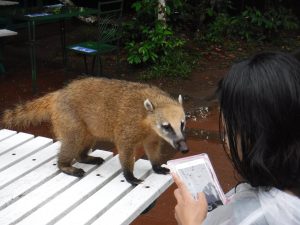
by Alex Bowles | Jan 14, 2018 | Alex, South America
Iguassu falls is considered one of the seven natural wonders of the world. Iguassu Falls isn’t just one waterfall, but a collection of over three hundred waterfalls each pouring huge amounts of water onto the rocks below. The cascade’s impact creates huge clouds of mist that can raise as high as 500 feet into the air, moving and breathing like a living creature. To get to the falls you have to walk on winding paths which you share with numerous animals. The most common inhabitant of the park is the Coati. They look like a raccoon crossed with a badger with a longer tail, a mostly tan and black color and a long snout. They are as common as squirrels in the United States. Our first morning at our hotel we saw one approach us and it didn’t mind us. We saw a whole family of them run across the street. After a few minutes, there were about 40 – 50 coatis in the area about the same size of a classroom running and climbing palm trees. My favorite thing to do on the Brazil side was Macuco boat tours. The boat tours took us up the lower Iguassu river up to the Three Musketeers Waterfalls and into the downpour, drenching everyone. Before we boarded the boat they passed out rain ponchos and I didn’t take one but my family did and found out that they did not work too well. We were given a small hint on how wet we would be when the boat driver stopped the boat for a couple minutes to put on a dry suit. Both countries national parks have boat tours that take you into the falls but the Brazilian tour is more frequent and organized. On the Brazil side located inside the park is the Belmont hotel. We stayed in the Belmont and could walk across the street any time and see the falls. We were warned not to walk around at night because there were Jaguars and Pumas that stalk the trails at night. On the Argentine side is the Melia hotel. Many of the rooms, like ours, have a view of the Devils Throat, the biggest waterfall in Iguazu Falls. Like the Belmont, you can walk to the park from the hotel. The trails take you to the many winding paths that give you excellent views of the numerous waterfalls. In the food court at lunch time, monkeys and coatis looking for food climb tables and attempt to steal anything edible.

Trying to steal lunch.
The Argentine side has a trail that will take you to an elevated metal catwalk that extends for more than a kilometer across the Iguassu River to the Devils Throat, or as it is called in Argentina, Garganta del Diablo. To get to the trail you have to ride one of the slowest trains in existence. It was so slow I thought I could walk faster. It rained for almost the entire day except when we were inside eating lunch.
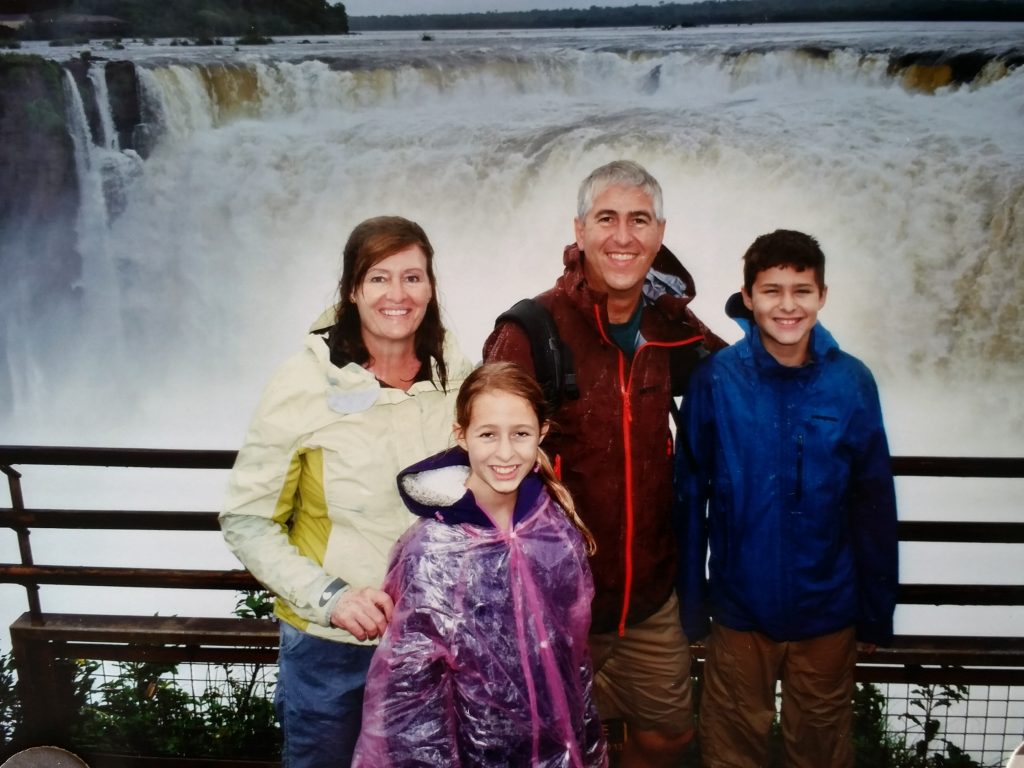
Garganta del Diablo
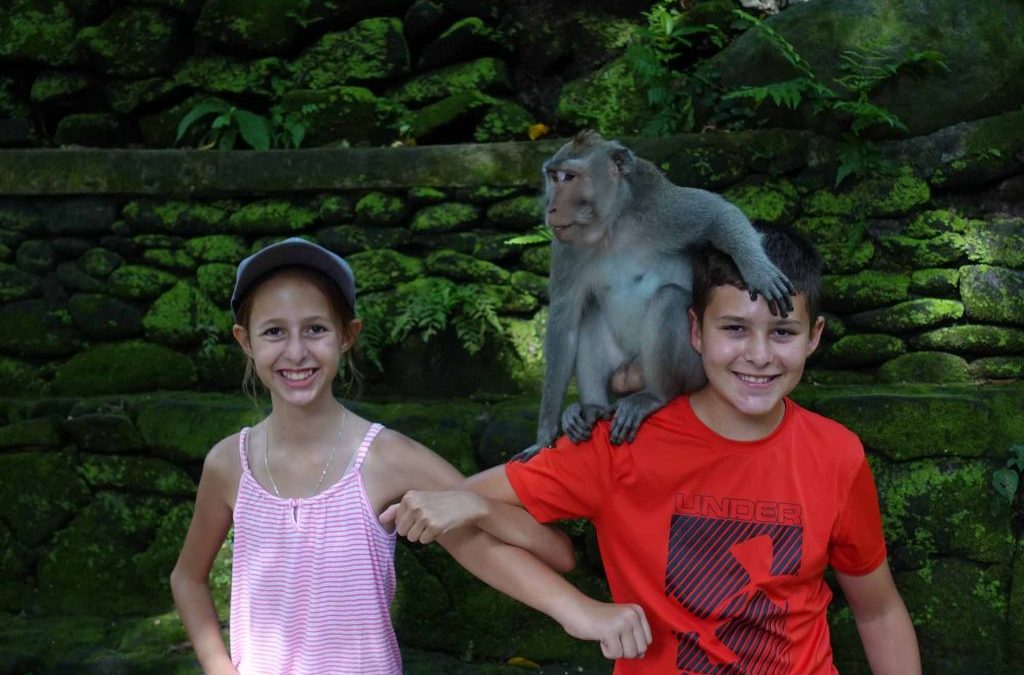
by Alex Bowles | Dec 10, 2017 | Alex, Indonesia
Bali was great, and it is a shame that we were only able to stay one day. In the short time we were here we went to a place I would recommend to anyone that comes to Bali, the Monkey Forrest in Ubud. It is a small forest with paths and statues that is home to more than six hundred wild monkeys. When you go through the main entrance you go into a small tunnel that takes you above a small road. From there we got our first view of the Monkey Forest and about 5 of the native monkeys. From there we looked down the path and saw monkeys running and sliding down the handrails. At the bottom of the small path, there were people selling bananas to feed the monkeys. We decided to buy some, and I am glad we did. At the nearest Banyan tree one of the workers there, equivalent to a park ranger in National Parks, showed us how to attract monkeys onto your shoulder. You would hold your arm out straight and strong and a monkey would run over and jump on your arm knowing that you would give it food. Maile got a monkey on her first and she enjoyed it. Next, I got one on me that was a sloppy eater. He ate the banana while on my head and dripped a fourth of it on my hair. My dad tried it at a different place and got two monkeys on his head. My mom was the only one that didn’t get a monkey on her because she said she would flinch and scream. When we tried to take a family photo a monkey climbed on my dad while he was sitting next to mom, and she sat still, at least until the picture was taken. After that, she walked away quickly.

The Monkey Forest, Ubud Bali
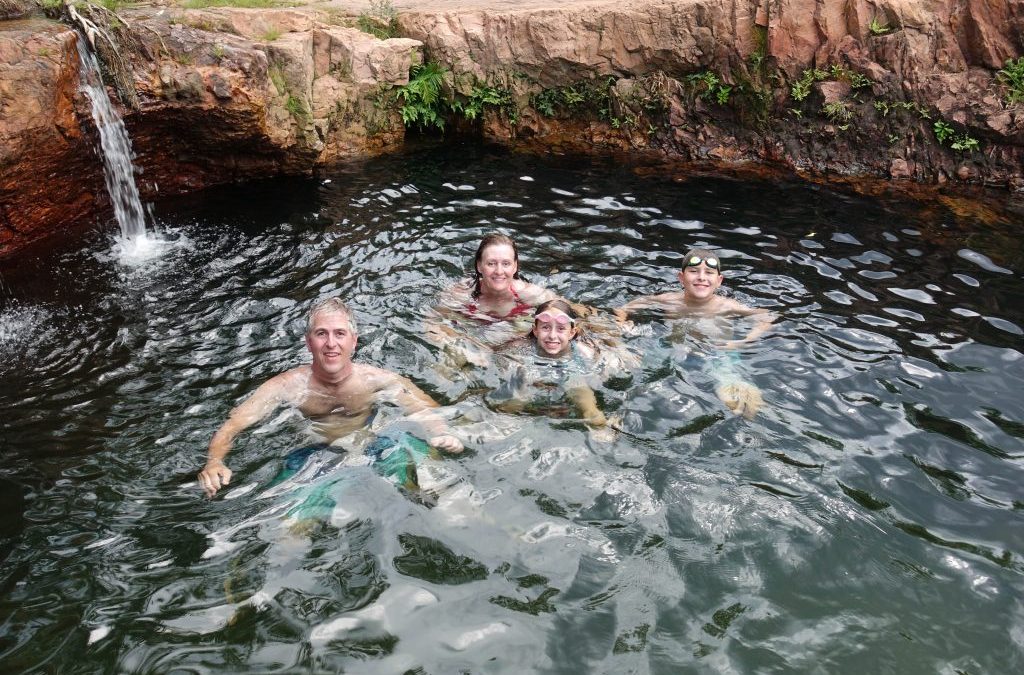
by Alex Bowles | Dec 1, 2017 | Alex, Australia
Australia is amazing! There are so many fun things to do here that I would do again on short notice. The first fun thing we did was climb the Sydney Harbor Bridge. It was nice because when up there you could see for miles and see the Sydney skyline from a different perspective. The next fun thing we did which was my favorite was diving the Great Barrier Reef. It was so amazing seeing all the fish and the huge and small turtles swimming in and around the colorful reef. Next, we took a helicopter tour of Uluru and Kata Tjuta and sunset. It was amazing because from up there you can see the colors of the rock in a way that you can’t get from looking up from the ground. Finally, to end the trip to Australia with something to remember, we swam in the numerous waterholes of Litchfield National Park. The swimming holes were filled with crystal clear water and numerous fish. Australia has many more fun things to do that we couldn’t do because I wasn’t old enough. Two that I really wanted to do were skydiving Uluru and swimming with crocodiles in The Cage of Death. Maybe next time when I am a little older.
Another interesting thing about Australia is the food they eat. Because Australia has many unique animals they have a very unique menu. One item which you can find at every breakfast buffet is the terrible substance known as Vegemite. It has the consistency of butter, the color of motor oil and tastes like &!@#$. If you ever try it have a gallon of water to wash away the taste. My favorite thing on the menu was kangaroo, it tastes like beef not chicken. There are many ways to prepare kangaroo including but not limited to, kangaroo burgers, kangaroo loin, kangaroo steak and kangaroo jerky. I have tried the first two options and am planning on taking the final option home with me. Other animals that were on the menu that I didn’t have the time to try were emu drumsticks, Asian water buffalo steak, camel hump and crocodile tail.
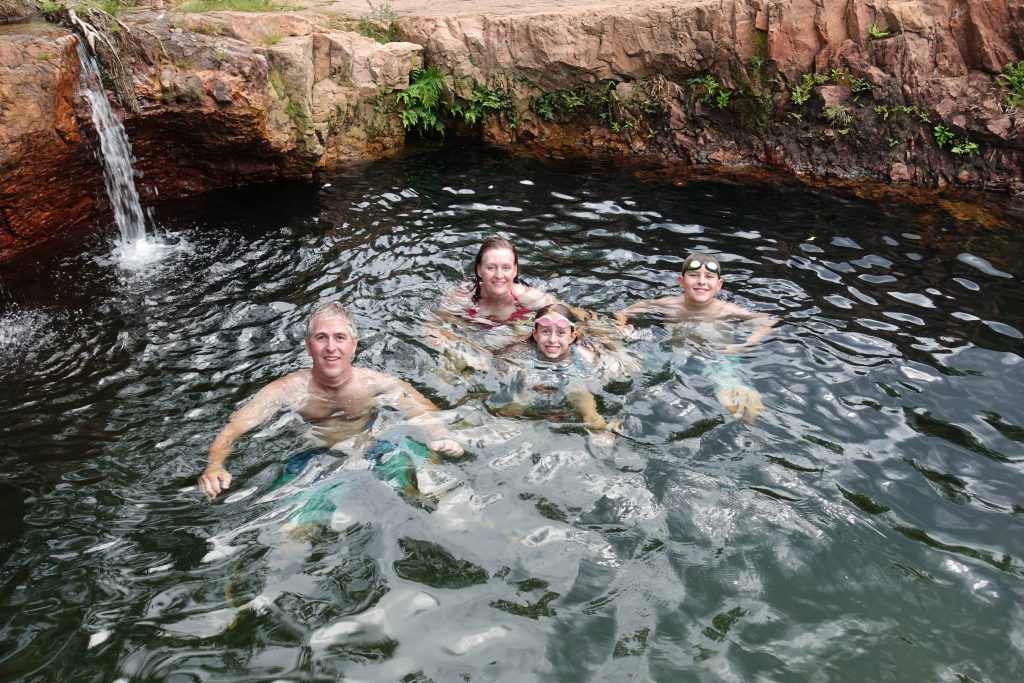
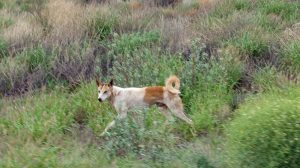
by Alex Bowles | Nov 26, 2017 | Alex, Australia
Australia is home to many interesting animals. The kangaroo, the most iconic Australian animal, lives in the desert and forest and is the largest marsupial. The kangaroo is also a delicacy. I have been eating kangaroo in every form possible and in my opinion it tastes like beef. There is even a species of kangaroo known as the Tree Kangaroo that lives in Indonesia and has been seen to jump off trees 18 meters or 60 feet. The wallaby is a smaller version of a kangaroo that will sometimes breed with kangaroos creating wallaroos. Another iconic animal is the koala. The koala lives on a diet of eucalyptus leaves and sleeps for 18-20 hours of the day. The koala has three fingers and two thumbs to help it climb trees. The most bizarre of Australia’s creatures is the platypus. The platypus is a mammal with a bill like a duck and a tail like a beaver, the platypus is the only mammal to lay eggs. Crocodiles live in the Northern Territory and can live in billabongs (swamps) and the ocean. They normally grow to a length of 6 meters or 20 feet and can jump out of the water to catch food. The cockatoo is a white bird with a yellow crest that can fold off the head. A displayed crest means that the bird is scared or curious to make it seem bigger. The dingo is a relative of the dog that can live in the harshest areas of the Australian Outback. Dingos will mate for life and will sometimes mourn themselves to death after the loss of their mate. Camels are originally from the Middle East but can only be found wild in Australia. The camels are dromedary camels and were imported in the mid-1800’s. People now estimate there are about 1,000,000 wild camels roaming the Outback.

by Alex Bowles | Nov 20, 2017 | Alex, Australia
One of the most predominant animals at Heron Island is the green sea turtle. When they are born they make a rush to the water where about 10% will be eaten. After getting to the water they must get through the reef where about 75% are eaten. After they make it to the open sea they will spend ten years drifting until they are ten years old and the size of a dinner plate. When they reach that size, they go to a reef where they will spend the next ten years of their life. After those ten years, they go back to the open ocean and will return to the same beach or within 60 kilometers of the beach to lay their eggs. After the females lay their eggs at high tide in the night they will go back to the water and in a short period of time lay another batch of eggs. Each batch of eggs will have about between 150 eggs to 800 eggs. In one breeding season, one female can lay up to six batches of eggs.

by Alex Bowles | Aug 6, 2017 | Alex, Scotland
Edinburgh has a very rich history. It has been the capital of Scotland for 300 years, but people have been living in the city since 8500 B.C. Not known to many visitors of this amazing city is another city where people lived under the streets and bridges. To see the underground city, we booked a tour with Mercat tours–mercat being the old Scottish word for market. To get to the entrance we went through a small alleyway where our guide, Artemis, told us about the nasty buckets. Edinburgh was not built near a river so plumbing did not exist for quite some time. Each family shared a bucket that became known as the nasty bucket. To empty it they poured the contents out of the window at night after yelling “Attention à l’eau,!” The only way to stop it was to yell and wave your hands. Knowing that the buildings in Edinburgh at that time were up to 14 stories tall, there was a lot of nasty raining down and filling the streets. After that, we arrived at the entrance to the underground city. After traveling down a steep flight of stairs we entered the underground city. In the first room, Artemis told us about how they kept a record of the paranormal activity in the rooms. In the room where we stood, the ghost of an aristocrat was often sighted standing in the doorway looking at the other doorway as if it were waiting for someone. In the next room, The Watcher was first sighted. Named because all he did was watch–at least in the beginning. Artemis then gave us a short history in the next room. At first, all he did was watch the group, occasionally walking around to get a better look at everyone in the group. That peaceful version disappeared and he started running through the halls. We heard what sounded like footsteps and Artemis told us it was just another group entering the rooms. After that we entered the next room, the second most active room in the underground city. In it, a small man would smile and wave at groups passing through. He never hurt anyone but some people say they heard rocks being thrown at the walls. Another spirit was present every now and then, a small ten-year-old boy that would hold hands or untie your shoes as a joke. This room got the nickname the safe room because the watcher was never seen inside the room but would look inside. The next room was believed to be a bar because oyster shells were found inside with glass bottle-shards. We all crowded into the next room except for Artemis. It was a small room and the most active. She told us this was believed to be The Watchers lair. In this room, people left the room with scratches and bruises from unknown sources. One of the sightings had The Watcher grab a person around the neck and yell at her. Artemis had never seen a ghost in the rooms but another group she had two weeks before our tour said they saw something walk past her and look over her shoulder.

Underground city











